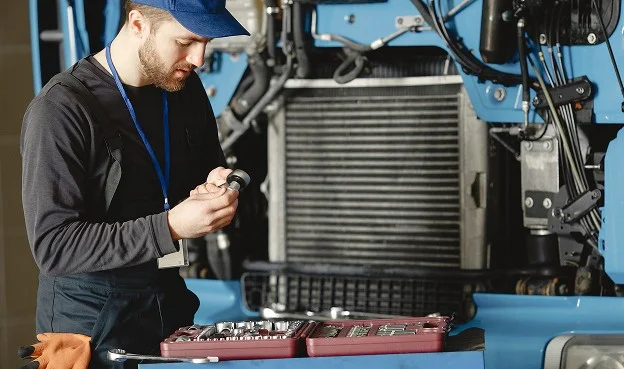
The short answer for how many miles per gallon (MPG) a semi-truck gets is about 6.5-7.5 miles per gallon.
In comparison, passenger vehicles get about 25 miles per gallon and tend to weigh anywhere from 2,500 to 6,000 pounds. The reason for the huge difference in MPG between passenger vehicles and semi trucks is the weight of semi trucks, which can be up to 80,000 pounds.
While semi-trucks aren’t necessarily known for their fuel economy, every extra mile counts. Especially if you’re a fleet operator managing multiple semi trucks that need regular truck maintenance, doing everything in your power to improve your semi’s fuel efficiency goes a long way.
After more than 20 years in the diesel truck repair industry, we’ve found that the average MPG for semi trucks depends on the care you provide your truck.
So, what’s the average miles per gallon for a semi-truck, and how can you optimize your fleet’s fuel usage? And, as a result of fuel usage, how can you reduce fuel costs?
If you’re looking for information about miles per gallon for semi-trucks, as well as tips to improve your MPG for your semi-truck, you’ve come to the right place.
In this article, we’ll walk you through:
| 1. Keep tabs on your speed: Maintaining a constant speed means maintaining steady fuel usage. Do your best to stay in one gear as long as possible. For every mile-per-hour (MPH) increase above 55 MPH, your vehicle’s fuel efficiency goes down by 0.1 MPG. 2. Avoid idling: Avoid idling when possible, even if the weather is cold. For every hour of idling, your truck can burn about a gallon of diesel. 3. Use cruise control on long highway stretches: Steady and safe speeds mean more consistent miles per gallon for you and your vehicle. 4. Check your tire pressure: Underinflated tires can lead to a decrease in fuel consumption. 5. Drive carefully on slippery roads: maintaining steady, safe, and smooth driving will help combat rolling resistance and the effort your engine expends on keeping your vehicle moving. At the same time, steady, safe driving will ensure you receive more MPG. 6. Drive in the highest possible gear for as long as possible: The truck’s highest gear can reduce the revolutions per minute of your vehicle and help you gain more miles per gallon. 7. Keep your fuel tank full, but don’t overfill it: Overfilling a fuel tank can interfere with the vehicle’s fuel injection system, leading to a decrease in power, acceleration, and fuel efficiency. 8. Check your vehicle’s air deflectors for correct positioning: If an air deflector isn’t in its proper place, roof racks can create drag. When drag occurs, a truck must work harder, and therefore, more precious fuel is consumed. |

Before we dive into the average miles per gallon for semi-trucks, we need to compare new versus older semi-trucks. Newer semi-trucks tend to need more fuel to operate at peak capacity.
Transporting heavy cargo in a heavy truck across the country means loads of fuel are needed. But, how much fuel exactly?
The short answer is: it depends. It depends on the truck make and model, the driver’s behavior, and weather conditions on the road.
Semi trucks that are 10 years or older often receive an average of five miles per gallon. Part of the reason that trucks a decade or younger tend to be more fuel-efficient is because of legislative changes.
For example, in 2014, the Obama administration’s Department of Transportation and Environmental Protection Agency set new fuel efficiency standards for heavy- and medium-duty trucks.
The legislation stated that any trucks produced after 2014 were required to be more fuel efficient, specifically to have a fuel economy of at least 7.2 MPG.
According to a 2024 report from GeoTab, a platform for fleet performance, Class 7 and Class 8 trucks in the United States and Canada averaged 4.51-6.47 MPG across all 50 states and select Canadian provinces.
So, while the 2014 fuel standards are mandated, our average MPG on the road hasn’t quite aligned yet. The good news is that since semi trucks can rack up to a million or more miles, we still have time to reach that 7.2 MPG benchmark.
Meanwhile, let’s take a look at some of the trucks that get the best fuel mileage on the market.

Considering that semi-trucks are an investment of $100,000, $200,000, or more, you want to make sure that your trucks receive the best fuel mileage possible.
While this price tag is one of many factors that may affect your purchase decision, you want to keep in mind the average fuel mileage of your semi-truck.
The trucks on today’s market that tend to receive the best fuel mileage include:
If you’re not on the market for a new truck, you might want to consider a few factors that impact fuel efficiency.

Whether you’re on the market for a new semi-truck or own a used semi-truck, understanding the factors that impact the average gas mileage and MPG range of a semi-truck is key to boosting your fuel economy.
Three major factors play an important role in semi-truck fuel efficiency:
We’ll dive into each in the next sections.
Newer trucks mean newer designs. Newer models of trucks include technologies and design elements that can increase a semi-truck’s total mileage. The following truck design elements are key for improving the fuel economy of semi-trucks.
But a truck design isn’t the only factor that affects the fuel consumption of a semi-truck. It’s all about how you drive your rig.
Even with the latest technology, if the person driving the truck exhibits erratic driving behaviors, you’re going to experience a dip in MPG. To improve your average MPG, fleet managers and owner-operators need to learn how to practice safe, fuel-efficient driving.
Driving behaviors to avoid that will improve fuel efficiency include:
Fleet managers: investing in your driver will pay dividends for your truck’s fuel economy.
Even the most seasoned truck owners and drivers can’t compete with the elements. Fuel savings and fuel capacity decrease as you experience detours, slow construction zones, and frequent stops.
Regardless of the make and model of the truck, depending on the route of the trip, you’ll experience a difference in fuel economy.
One of the many ways to improve your fuel efficiency is by planning your route well in advance to minimize frequent stops, detours, and high-traffic areas with many passenger cars and pedestrians.
As part of your overall fleet management strategy to improve fuel efficiency, consider opting for integrated route planning systems that automate the route-planning process.

This may seem like a simple formula, but it’s worth keeping in mind as fleet managers to manage fuel costs.
To calculate MPG, follow this formula:
MPG = Miles driven ÷ Gallons of fuel used
For example, if your truck drove 1,200 miles and used 160 gallons of diesel, your average MPG would be:
1,200 ÷ 160 = 7.5 MPG
Knowing the average MPG of your entire fleet team can help you plan a comprehensive fuel management plan and a more complete budget for all your fleet needs.
Note: If you’re looking for fun and informative fleet management support, you’ll love our 2-minute-or-less fleet manager video series.
Did you know that traffic congestion costs the trucking industry over $74 billion annually? Fleet managers: you can avoid costly delays and reduce fuel consumption with smart route planning and telematics.
For more helpful facts about fleet management, check us out on IG, or give us a call at (253) 365-6591.

Noticed that your semi-truck’s fuel economy is lower than usual? Struggling to keep up with rising fuel costs? It could be driving habits.
But more likely, it could be a sign of:
Can we help?
At our diesel truck repair facility, we’ve helped trucking companies, truck owners, and fleet operators with all their fuel economy issues for semi-trucks of all makes and models.
Whether you need a quick inspection or a full fuel system overhaul in-shop or at your desired location, our Experts come toolkit-ready to get you up and running again.
For help with all your fuel needs, don’t hesitate to contact one of our knowledgeable diesel technicians for comprehensive, quick, and reliable service.
Equipment Experts: Fuel-Efficient Fleet Services for All Your Hauling Needs